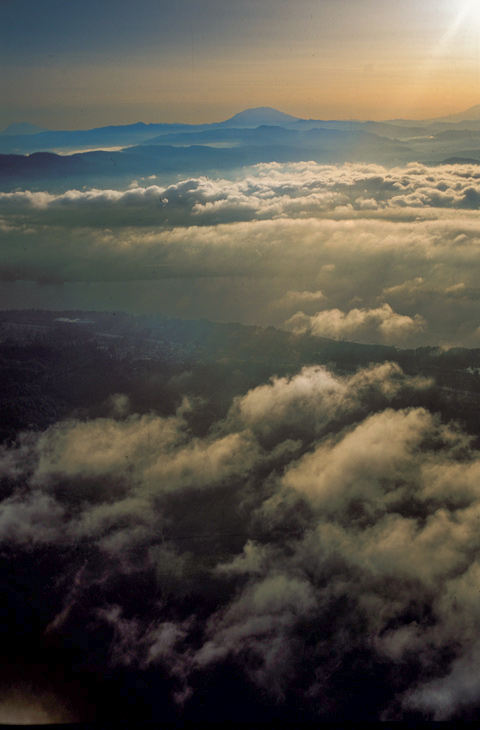Three peaks rise above low cloud banks in this early morning view across the Columbia River near Kelso, Washington. The Corps of Discovery recognized them from several different points on the Columbia.
At center is Mount St. Helens. In 1792, on his expedition in the area, British explorer George Vancouver named the volcano for Baron St. Helens, a prominent British diplomat. There is evidence that it may have erupted just a few years before Lewis and Clark passed by. At the time, Mount St. Helens’ summit was 9,677 feet above sea level. Nearly two centuries later, on 18 May 1980, an eruption (perhaps the volcano’s seventh in forty thousand years) blew away the top 1,300 feet.
Vancouver also named 14,410-foot Mount Rainier (at left edge of the photo), after his friend Rear Admiral Peter Rainier. Scientists consider this majestic peak the most dangerous volcano in the Cascade Range because of its proximity to the populous Seattle-Tacoma area.
Partially shown at far right, Mount Adams last erupted about 3,500 years ago. In 1838, a patriotic citizen started a campaign to change the Cascade Mountains into the “Presidential Range.” This was to include renaming Mount Hood after John Adams. The whole plan collapsed in short order, but in a series of mix-ups Adams’s name was affixed instead to this 12,276-foot mountain fifty miles north of Mount Hood.
From Discovering Lewis & Clark from the Air
Photography by Jim Wark
Text by Joseph Mussulman
Reproduced by permission of Mountain Press
Experience the Lewis and Clark Trail
The Lewis and Clark Trail Experience—our sister site at lewisandclark.travel—connects the world to people and places on the Lewis and Clark Trail.
Discover More
- The Lewis and Clark Expedition: Day by Day by Gary E. Moulton (University of Nebraska Press, 2018). The story in prose, 14 May 1804–23 September 1806.
- The Lewis and Clark Journals: An American Epic of Discovery (abridged) by Gary E. Moulton (University of Nebraska Press, 2003). Selected journal excerpts, 14 May 1804–23 September 1806.
- The Lewis and Clark Journals. by Gary E. Moulton (University of Nebraska Press, 1983–2001). The complete story in 13 volumes.


